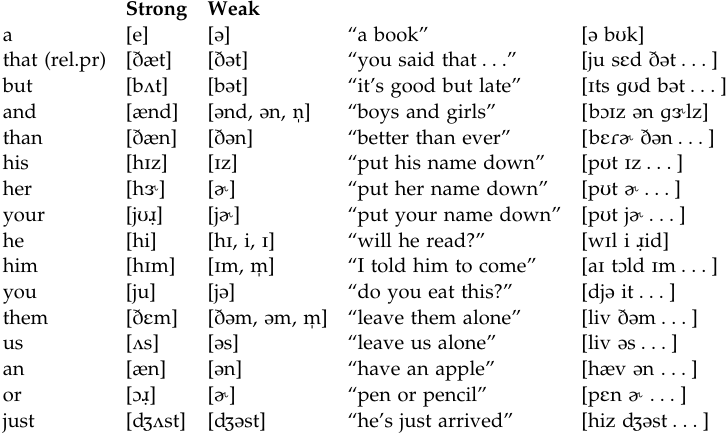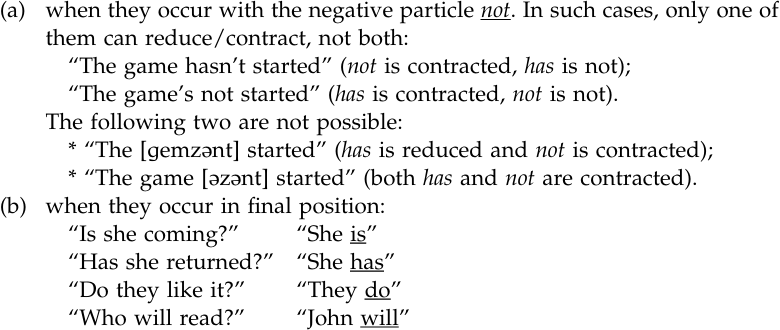


 Grammar
Grammar
 Tenses
Tenses
 Present
Present
 Past
Past
 Future
Future
 Parts Of Speech
Parts Of Speech
 Nouns
Nouns
 Verbs
Verbs
 Adverbs
Adverbs
 Adjectives
Adjectives
 Pronouns
Pronouns
 Pre Position
Pre Position
 Preposition by function
Preposition by function 
 Preposition by construction
Preposition by construction
 Conjunctions
Conjunctions
 Interjections
Interjections
 Grammar Rules
Grammar Rules
 Linguistics
Linguistics
 Semantics
Semantics
 Pragmatics
Pragmatics
 Reading Comprehension
Reading Comprehension|
Read More
Date: 2024-05-08
Date: 2024-03-22
Date: 2024-05-29
|
Full (Strong) Forms versus Reduced (Weak) Forms of Function Words
The pronunciations of words reveal differences, whether we consider them in isolation (i.e. citation form) or in connected speech. The latter is a very fertile context for accommodating many changes, especially for unstressed monosyllabic function words (free grammatical morphemes). The class of function words includes auxiliaries, prepositions, articles, conjunctions, pronouns, and some adverbs. In connected speech utterances, such words are typically not the focus of information (they are unstressed), and thus they readily lend themselves to reduction. The reduced forms are very common in connected speech, and their under-use (i.e. employing the strong (full) forms) quickly strikes the native speaker’s ear as unnatural. Also, learners who have no familiarity with these forms are likely to have difficulty understanding native speakers who use them regularly in connected speech. Thus, learners should be frequently reminded of this aspect of English phonology. The existence of strong and weak forms, although limited to a few dozen words, is very significant since these are some of the most basic words of the language, with a very high frequency of use. As will be obvious from the list below, some of these function words have more than one weak form. While some of these variations are predictable (e.g. [ðə] before consonants as in the book [ðə bʊk], and [ði] before others as in the apple [ði æpəl]), many others are far from being invariable. Also noteworthy are the cases where two identically spelt words behave differently. For example, while that as a relative pronoun, as in “You said that she ate”, is reduced to [ðət], the identically spelt demonstrative that, as in that boy, is not reduceable, and is always pronounced as [ðæt].
Before we list the items in question, we would like to remind the reader that the citation form in isolation is not the only context that the strong (full) forms of these words can be used in. They are also expected when these words become the focal point in the exchange; for example, when given special emphasis, as in:
A: “We can serve strawberries or grapes for dessert.”
B: “I think we should serve strawberries and grapes.”
or to make a contrast (assertion), as in:
A: “I can’t finish this job by Tuesday.”
B: “Yes you can.”
While the reduced forms [ən] and [kən] are the expected forms in normal running speech, in the above examples the words will be uttered in their full form, [ænd] and [kæn] respectively, when they become the focus of the exchange.
Strong and weak forms of some common function words in English follow:

In addition to these, the words in the following group occur in their strong forms when they are in sentence-final position:

Some of these function (minor) words also have contracted forms made by losing their vowel and consequently merging with the preceding syllable.

It is worth mentioning that prepositions and auxiliary verbs have certain requirements for their reduced forms. Thus, for example, the preposition “by” behaves differently in the following two sentences:
(a) He walked by the other day.
(b) He walked by the other route.
The reduced form occurs only in (b) because the preposition is followed by a noun phrase (i.e. by has an object noun phrase and thus is a ‘transitive’ preposition). The ‘intransitive’ (with no object) preposition by in (a) is stressed and does not reduce.
Auxiliary verbs are typically unstressed and are reduced or contracted, except:

Finally, we should point out that reduced vowels are not restricted to function words only, and are found in lexical morphemes (nouns, verbs, adjectives, adverbs) too.
|
|
|
|
4 أسباب تجعلك تضيف الزنجبيل إلى طعامك.. تعرف عليها
|
|
|
|
|
|
|
أكبر محطة للطاقة الكهرومائية في بريطانيا تستعد للانطلاق
|
|
|
|
|
|
|
أصواتٌ قرآنية واعدة .. أكثر من 80 برعماً يشارك في المحفل القرآني الرمضاني بالصحن الحيدري الشريف
|
|
|